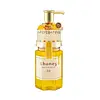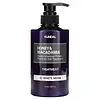&Honey Deep Moist Hair Oil 3.0 Versus Kundal Honey & Macadamia Hydro-Intensive Protein Premium Hair Treatment
What's inside
What's inside
 Key Ingredients
Key Ingredients

 Benefits
Benefits

 Concerns
Concerns

 Ingredients Side-by-side
Ingredients Side-by-side

Cyclopentasiloxane
EmollientDimethicone
EmollientHydrogenated Polyisobutene
EmollientElaeis Guineensis Kernel Oil
EmollientHoney
HumectantHoney Extract
HumectantHydrolyzed Honey Protein
Skin ConditioningRosa Damascena Flower Extract
MaskingArgania Spinosa Kernel Oil
EmollientPanthenol
Skin ConditioningGluconobacter/Honey Ferment Filtrate
Skin ConditioningKeratin
Skin ConditioningRoyal Jelly Extract
Skin ConditioningPropolis Extract
Skin ConditioningC9-11 Alkyl Glucoside
CleansingHydroxypropyltrimonium Hyaluronate
Ceramide Ng
Skin ConditioningCeramide NP
Skin ConditioningCeramide AP
Skin ConditioningHydrolyzed Silk
HumectantGlycerin
HumectantTocopherol
AntioxidantQuaternium-18
Quaternium-33
Cholesterol
EmollientButylene Glycol
HumectantPropylene Glycol
HumectantPhenoxyethanol
PreservativeWater
Skin ConditioningParfum
MaskingCyclopentasiloxane, Dimethicone, Hydrogenated Polyisobutene, Elaeis Guineensis Kernel Oil, Honey, Honey Extract, Hydrolyzed Honey Protein, Rosa Damascena Flower Extract, Argania Spinosa Kernel Oil, Panthenol, Gluconobacter/Honey Ferment Filtrate, Keratin, Royal Jelly Extract, Propolis Extract, C9-11 Alkyl Glucoside, Hydroxypropyltrimonium Hyaluronate, Ceramide Ng, Ceramide NP, Ceramide AP, Hydrolyzed Silk, Glycerin, Tocopherol, Quaternium-18, Quaternium-33, Cholesterol, Butylene Glycol, Propylene Glycol, Phenoxyethanol, Water, Parfum
Water
Skin ConditioningCetearyl Alcohol
EmollientStearyl Alcohol
EmollientDimethicone
EmollientBehentrimonium Chloride
PreservativeCyclopentasiloxane
EmollientPropylene Glycol
HumectantAmodimethicone
Alcohol
AntimicrobialTocopheryl Acetate
AntioxidantDimer Dilinoleyl Dimer Dilinoleate
EmollientCaprylic/Capric Triglyceride
MaskingHydroxyacetophenone
AntioxidantDipropylene Glycol
HumectantTrehalose
HumectantSteartrimonium Chloride
PreservativeCaprylyl Glycol
EmollientC12-14 Sec-Pareth-7
EmulsifyingMacadamia Ternifolia Seed Extract
EmollientHoney Extract
HumectantBetaine
HumectantDisodium EDTA
Cyclomethicone
EmollientTrideceth-10
CleansingButylene Glycol
HumectantArachidyl Alcohol
EmollientPanthenol
Skin Conditioning1,2-Hexanediol
Skin ConditioningCetyl Alcohol
EmollientCitric Acid
BufferingBrassicamidopropyl Dimethylamine
Skin ConditioningDipotassium Glycyrrhizate
HumectantCalendula Officinalis Flower Oil
MaskingCocos Nucifera Oil
MaskingPersea Gratissima Oil
Skin ConditioningButyrospermum Parkii Butter
Skin ConditioningPrunus Armeniaca Kernel Oil
MaskingSclerocarya Birrea Seed Oil
HumectantSilk Amino Acids
HumectantCyclohexasiloxane
EmollientHydrolyzed Soy Protein
HumectantHydrolyzed Collagen
EmollientHydrolyzed Keratin
HumectantHydrolyzed Silk
HumectantGlycerin
HumectantPolygonum Multiflorum Root Extract
Skin ConditioningAngelica Gigas Root Extract
Skin ConditioningAsarum Sieboldii Root Extract
Skin ConditioningPortulaca Oleracea Extract
Skin ConditioningThuja Orientalis Leaf Extract
AntioxidantLycium Chinense Fruit Extract
AntioxidantSophora Angustifolia Root Extract
Skin ConditioningNelumbo Nucifera Flower Extract
Skin ConditioningPrunus Serrulata Flower Extract
Skin ConditioningSalvia Officinalis Extract
AntimicrobialCamellia Japonica Flower Extract
EmollientPropolis Extract
Skin ConditioningAcorus Calamus Root Extract
PerfumingMalpighia Emarginata Fruit Extract
Skin ConditioningEuterpe Oleracea Fruit Extract
Pyrus Malus Fruit Extract
Skin ConditioningPrunus Serotina Fruit Extract
MaskingPrunus Persica Fruit Extract
AbrasiveAdansonia Digitata Seed Extract
Skin ConditioningMoringa Oleifera Seed Extract
Skin ConditioningLaminaria Japonica Extract
Skin ProtectingCarthamus Tinctorius Flower Extract
Skin ConditioningGinkgo Biloba Leaf Extract
Skin ConditioningSodium Hyaluronate
HumectantCeratonia Siliqua Fruit Extract
MaskingCamellia Japonica Leaf Extract
Skin ConditioningDiospyros Kaki Fruit Extract
Skin ConditioningParfum
MaskingWater, Cetearyl Alcohol, Stearyl Alcohol, Dimethicone, Behentrimonium Chloride, Cyclopentasiloxane, Propylene Glycol, Amodimethicone, Alcohol, Tocopheryl Acetate, Dimer Dilinoleyl Dimer Dilinoleate, Caprylic/Capric Triglyceride, Hydroxyacetophenone, Dipropylene Glycol, Trehalose, Steartrimonium Chloride, Caprylyl Glycol, C12-14 Sec-Pareth-7, Macadamia Ternifolia Seed Extract, Honey Extract, Betaine, Disodium EDTA, Cyclomethicone, Trideceth-10, Butylene Glycol, Arachidyl Alcohol, Panthenol, 1,2-Hexanediol, Cetyl Alcohol, Citric Acid, Brassicamidopropyl Dimethylamine, Dipotassium Glycyrrhizate, Calendula Officinalis Flower Oil, Cocos Nucifera Oil, Persea Gratissima Oil, Butyrospermum Parkii Butter, Prunus Armeniaca Kernel Oil, Sclerocarya Birrea Seed Oil, Silk Amino Acids, Cyclohexasiloxane, Hydrolyzed Soy Protein, Hydrolyzed Collagen, Hydrolyzed Keratin, Hydrolyzed Silk, Glycerin, Polygonum Multiflorum Root Extract, Angelica Gigas Root Extract, Asarum Sieboldii Root Extract, Portulaca Oleracea Extract, Thuja Orientalis Leaf Extract, Lycium Chinense Fruit Extract, Sophora Angustifolia Root Extract, Nelumbo Nucifera Flower Extract, Prunus Serrulata Flower Extract, Salvia Officinalis Extract, Camellia Japonica Flower Extract, Propolis Extract, Acorus Calamus Root Extract, Malpighia Emarginata Fruit Extract, Euterpe Oleracea Fruit Extract, Pyrus Malus Fruit Extract, Prunus Serotina Fruit Extract, Prunus Persica Fruit Extract, Adansonia Digitata Seed Extract, Moringa Oleifera Seed Extract, Laminaria Japonica Extract, Carthamus Tinctorius Flower Extract, Ginkgo Biloba Leaf Extract, Sodium Hyaluronate, Ceratonia Siliqua Fruit Extract, Camellia Japonica Leaf Extract, Diospyros Kaki Fruit Extract, Parfum
 Reviews
Reviews

Ingredients Explained
These ingredients are found in both products.
Ingredients higher up in an ingredient list are typically present in a larger amount.
Butylene Glycol (or BG) is used within cosmetic products for a few different reasons:
Overall, Butylene Glycol is a safe and well-rounded ingredient that works well with other ingredients.
Though this ingredient works well with most skin types, some people with sensitive skin may experience a reaction such as allergic rashes, closed comedones, or itchiness.
Learn more about Butylene GlycolCyclopentasiloxane, or D5, is a silicone used to improve texture of products and trap moisture.
D5 is considered lightweight and volatile. Volatile means it evaporates quickly after application. Once evaporated, D5 leaves a thin barrier that helps keep skin hydrated.
It is also an emollient. Emollients help soften the skin and prevent water loss. Silicones create a silky texture in products. D5 helps other ingredients become more spreadable.
Studies show D5 is safe to use in skincare products. We recommend speaking with a skincare professional if you have concerns.
Learn more about CyclopentasiloxaneDimethicone is a type of synthetic silicone created from natural materials such as quartz.
What it does:
Dimethicone comes in different viscosities:
Depending on the viscosity, dimethicone has different properties.
Ingredients lists don't always show which type is used, so we recommend reaching out to the brand if you have questions about the viscosity.
This ingredient is unlikely to cause irritation because it does not get absorbed into skin. However, people with silicone allergies should be careful about using this ingredient.
Note: Dimethicone may contribute to pilling. This is because it is not oil or water soluble, so pilling may occur when layered with products. When mixed with heavy oils in a formula, the outcome is also quite greasy.
Learn more about DimethiconeGlycerin is already naturally found in your skin. It helps moisturize and protect your skin.
A study from 2016 found glycerin to be more effective as a humectant than AHAs and hyaluronic acid.
As a humectant, it helps the skin stay hydrated by pulling moisture to your skin. The low molecular weight of glycerin allows it to pull moisture into the deeper layers of your skin.
Hydrated skin improves your skin barrier; Your skin barrier helps protect against irritants and bacteria.
Glycerin has also been found to have antimicrobial and antiviral properties. Due to these properties, glycerin is often used in wound and burn treatments.
In cosmetics, glycerin is usually derived from plants such as soybean or palm. However, it can also be sourced from animals, such as tallow or animal fat.
This ingredient is organic, colorless, odorless, and non-toxic.
Glycerin is the name for this ingredient in American English. British English uses Glycerol/Glycerine.
Learn more about GlycerinThis ingredient comes from honey made by bees. It is hydrating, antibacterial, anti-aging, and skin soothing.
Honey also contains amino acids, peptides, Vitamins A, C, and E.
The humectant property of honey draws moisture from the air to your skin. This makes it great at helping to hydrate the skin.
Honey may help reduce the signs of aging due to its antioxidant properties. Fun fact: darker honey has more antioxidants than light honey. The antibacterial property of honey may make it effective at helping to treat acne by killing acne-causing bacteria.
Many people wonder if honey extract is vegan. It is technically a byproduct from bees. This is because honey is created from the digestive enzymes in a bee's stomach.
Remember to be kind to bees :) They are important for many ecosystems and are endangered.
Learn more about Honey ExtractYou can find hydrolyzed silk in both haircare and skincare products. According to a manufacturer, it can help improve skin and hair hydration.
This ingredient is created by adding acid or enzymes to 'hydrolyze' silk protein.
Due to the origins of this ingredient, it is not vegan. Silk is an animal product from silkworms.
Depending on the source, this ingredient can be considered cruelty-free. It is created from left-over cocoons of silkworms. We recommend reaching out to the brand if you have questions about where their hydrolyzed silk comes from.
Learn more about Hydrolyzed SilkPanthenol is a common ingredient that helps hydrate and soothe the skin. It is found naturally in our skin and hair.
There are two forms of panthenol: D and L.
D-panthenol is also known as dexpanthenol. Most cosmetics use dexpanthenol or a mixture of D and L-panthenol.
Panthenol is famous due to its ability to go deeper into the skin's layers. Using this ingredient has numerous pros (and no cons):
Like hyaluronic acid, panthenol is a humectant. Humectants are able to bind and hold large amounts of water to keep skin hydrated.
This ingredient works well for wound healing. It works by increasing tissue in the wound and helps close open wounds.
Once oxidized, panthenol converts to pantothenic acid. Panthothenic acid is found in all living cells.
This ingredient is also referred to as pro-vitamin B5.
Learn more about PanthenolParfum is a catch-all term for an ingredient or more that is used to give a scent to products.
Also called "fragrance", this ingredient can be a blend of hundreds of chemicals or plant oils. This means every product with "fragrance" or "parfum" in the ingredients list is a different mixture.
For instance, Habanolide is a proprietary trade name for a specific aroma chemical. When used as a fragrance ingredient in cosmetics, most aroma chemicals fall under the broad labeling category of “FRAGRANCE” or “PARFUM” according to EU and US regulations.
The term 'parfum' or 'fragrance' is not regulated in many countries. In many cases, it is up to the brand to define this term.
For instance, many brands choose to label themselves as "fragrance-free" because they are not using synthetic fragrances. However, their products may still contain ingredients such as essential oils that are considered a fragrance by INCI standards.
One example is Calendula flower extract. Calendula is an essential oil that still imparts a scent or 'fragrance'.
Depending on the blend, the ingredients in the mixture can cause allergies and sensitivities on the skin. Some ingredients that are known EU allergens include linalool and citronellol.
Parfum can also be used to mask or cover an unpleasant scent.
The bottom line is: not all fragrances/parfum/ingredients are created equally. If you are worried about fragrances, we recommend taking a closer look at an ingredient. And of course, we always recommend speaking with a professional.
Learn more about ParfumPropolis Extract is also known as bee glue.
This ingredient has antimicrobial, anti-inflammatory, wound healing, and antioxidant properties.
Studies show propolis helps fight against bacteria, viruses, and fungi. This may help with reducing acne and accelerate wound healing.
The flavonoids found in propolis extract are potent antioxidants. Antioxidants may help with reducing the signs of aging.
A study from 2020 found propolis to help reverse skin damage from UV.
Fun facts: This ingredient is created by mixing beeswax, bee saliva, and parts of trees. Bees use propolis as a sealant to close any gaps in their hives.
Since it is an animal-derived product, this ingredient is not considered vegan. For vegan alternatives, check out Galactomyces Ferment Filtrate or Centella Asiatica Extract.
Learn more about Propolis ExtractPropylene Glycol is an odorless, colorless liquid. As a humectant, it helps skin retain moisture. It also aids in delivering active ingredients.
Another role of this ingredient is preventing a product from melting or freezing. Propylene glycol also adds antimicrobrial properties to a product, elongating product lifespan.
This ingredient is considered an organic alcohol and commonly added into both cosmetics and foods.
Those with sensitive skin or conditions may develop a rash when using this ingredient.
Learn more about Propylene GlycolWater. It's the most common cosmetic ingredient of all. You'll usually see it at the top of ingredient lists, meaning that it makes up the largest part of the product.
So why is it so popular? Water most often acts as a solvent - this means that it helps dissolve other ingredients into the formulation.
You'll also recognize water as that liquid we all need to stay alive. If you see this, drink a glass of water. Stay hydrated!
Learn more about Water